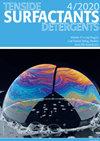Oil displacement properties of surfactin: a comparative study
IF 1.2
4区 工程技术
Q4 CHEMISTRY, APPLIED
引用次数: 0
Abstract
Abstract Biosurfactants are amphiphilic compounds synthesized from plants and microorganisms and are known for their high biodegradability, low toxicity, and eco-friendliness. They have diverse applications in industrial and environmental fields, including oil recovery, bioremediation, and cleaning up hydrocarbons from polluted areas. Surfactin is a potent lipopeptide biosurfactant produced by Bacillus subtilis bacteria. In this study, we produced surfactin by B. subtilis using cassava wastewater as the fermentation medium. This production was monitored by high performance liquid chromatography (HPLC). Approximately 600 mg L−1 of surfactant was produced. The oil displacement test was then performed to evaluate the effectiveness of crude and purified surfactin compared to a synthetic surfactant and a biosurfactant. Three types of surfactants were tested: the synthetic surfactant sodium lauryl sulfate (SDS), the commercial biosurfactant rhamnolipid (Rh), and surfactin in its crude form and purified one – after acid precipitation. The analysis results indicated that surfactin, in both its crude and purified forms, was more effective at dispersing oil than the other surfactants tested, even at lower concentrations. This suggests that biosurfactants have great potential as a more sustainable and effective alternative to petroleum-derived synthetic surfactants. Surfactin can be applied without the need for downstream processes.表面活性剂驱油性能的比较研究
摘要生物表面活性剂是由植物和微生物合成的两亲性化合物,具有高生物可降解性、低毒性和生态友好性。它们在工业和环境领域有多种应用,包括石油开采、生物修复和从污染地区清理碳氢化合物。表面素是枯草芽孢杆菌生产的一种有效的脂肽类生物表面活性剂。本研究以木薯废水为发酵培养基,利用枯草芽孢杆菌生产表面素。采用高效液相色谱法对生产过程进行了监测。表面活性剂的产量约为600 mg L−1。然后进行驱油试验,与合成表面活性剂和生物表面活性剂相比,评估粗表面活性剂和纯化表面活性剂的有效性。对三种表面活性剂进行了测试:合成表面活性剂十二烷基硫酸钠(SDS)、市产生物表面活性剂鼠李糖脂(Rh)、粗表面活性剂和经酸沉淀纯化的表面素。分析结果表明,即使在较低的浓度下,表面活性剂,无论是原始形式还是纯化形式,都比其他测试的表面活性剂更有效地分散油。这表明生物表面活性剂作为一种更可持续和有效的石油衍生合成表面活性剂的替代品具有巨大的潜力。表面素可以在不需要下游工艺的情况下应用。
本文章由计算机程序翻译,如有差异,请以英文原文为准。
求助全文
约1分钟内获得全文
求助全文
来源期刊

Tenside Surfactants Detergents
工程技术-工程:化工
CiteScore
1.90
自引率
10.00%
发文量
57
审稿时长
3.8 months
期刊介绍:
Tenside Surfactants Detergents offers the most recent results of research and development in all fields of surfactant chemistry, such as: synthesis, analysis, physicochemical properties, new types of surfactants, progress in production processes, application-related problems and environmental behavior. Since 1964 Tenside Surfactants Detergents offers strictly peer-reviewed, high-quality articles by renowned specialists around the world.
 求助内容:
求助内容: 应助结果提醒方式:
应助结果提醒方式:


